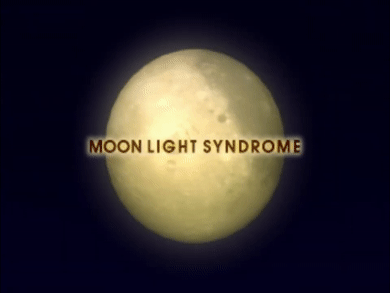As we established in エピローグ EPILOGUE, Moonlight Syndrome’s incomprehensible narrative was not completely dictated by artistic choice; several chapters were cut during production, most importantly 陰約 INYAKU, which would have provided a key to understanding some of the more mysterious aspects of the game.
Several books were published in the two months following the release of Moonlight Syndrome that attempted to clarify or at least hint at an interpretation for the events of the game.
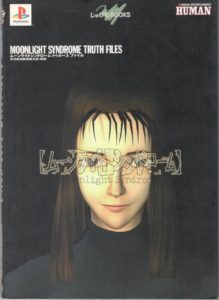
The first of them to be published, the Moonlight Syndrome Truth Files, is presented as a collage of in-universe newspaper and magazine articles and interviews by an unnamed researcher, detailing the events of the game from an outsider’s perspective.
While it does contain some new information, such as the full name of the stalker from 変嫉 HENSHITSU, it does not do much to clarify the events of the game, as the journalists cited are all unaware of the supernatural. It does however help put them in a sensible chronological order, which is impossible within the game itself due to how said events are depicted, and confirms that all the incidents from the ten scenarios did indeed take place within Hinashiro’s reality, as they are witnessed by other people, discounting the interpretation that the events of the game might have happened in Ryo’s inner world (which Suda would also later deny in the In-depth Guide Q&A).
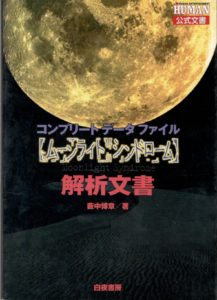
The following release, Moonlight Syndrome Complete Data Files, went further by including two of the game’s cut scenarios in the form of short stories: 予兆 YOCYOU (Omen) and 輪廻 RINNE (Death and Rebirth).
While it is unconfirmed, I believe that 予兆 YOCYOU was originally going to be the introduction of 夢題 MOWDEI rather than an independent scenario; it teases events that will later be relevant to 陰約 INYAKU and ends with “Continued in 夢題 MOWDEI”.
Meanwhile, 輪廻 RINNE was likely part of 陰約 INYAKU itself, seeing how it was folded into its scenario when it was rewritten as a short story.
予兆 YOCYOU (Omen)
In this chapter we get a glimpse of Mika Kishii’s inner world which is not thoroughly explained in the main game; namely, her own feelings of self hatred and frustration over having to play the role of “Mika Kishii” with her acquaintances. In fact, it opens in the Lost Highway club, as Mika is drowning her frustrations in alcohol and we are told that she’s not interested in techno or the clubbing scene at all, but in order to “fit in” with her classmates and friends, she could not afford to be ignorant about such subjects. Her only solace seems to be hanging out with Yukari, Chisato and Arisa, her closest friends whom she doesn’t have to “pretend” with as much. Arisa, despite being younger than her, often remarked on the fact that Mika needed to develop her own personality more. (Both of these subjects are breached in 開扉 KAIBYO as well, where Mika openly discusses her distaste for videogames with Arisa, while pretending to be an avid gamer with her classmates.)
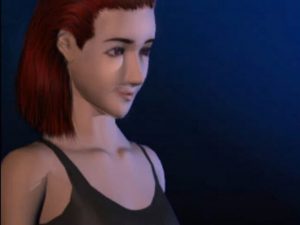
Just as she’s about to leave, she is accosted by Kimika Takahashi, who strikes up a conversation with her about her time at Hinashiro high. This is why 慟悪 DOWAKU mentions Mika and Kimika being friends.
Kimika seems to suspiciously try her hardest to keep Mika in the club with her, but Mika does not notice. They are eventually accosted by a noticeably uncool man named Suzuki, Kimika’s “friend” whom she actually leads on just so he can drive her around. (A manipulation tactic which Kimika likely learned during her relationship with Sumio.) She offers Mika to give her a ride, which Mika accepts.
As Mika tells Suzuki her address, Kimika proposes they take the road going through Reigetsu Pass (where Kyoko died in the accident) so they can look over from Moon Bridge. The two girls get out of the car, staring at Hinashiro from high up, discussing the growth of civilization against the beauty of nature. Kimika then abruptly changes the conversation to their love life: she asks Mika if she has a boyfriend (the implication being that she targeted Mika specifically because she knows she’s one of Sumio’s girls) and then reveals her own plight: she fell in love with a man who only wanted to use her for sex (Sumio), but she can’t help obsessing over him, almost revealing her own pregnancy to Mika. She stops herself only to tell Mika that unlike her, Kimika was never a popular girl at all, and Sumio took advantage of that. As she looks at Mika, Kimika strengthens her resolve to separate her from Sumio “in her own way”. (Implying this is where she decided on the suicide-homicide.)
Later that night, Mika sneaks back into her room. She remembers Kimika was nearly in tears when they said goodbye to each other, wondering if she could have done something wrong to her. She then wonders if he (Sumio) will call her that night.
輪廻 RINNE (Death and Rebirth), devoid of any context, depicts the contract between Ryo and Mithra. Its description implies that a flashback to it would have played out after Ryo destroyed Mithra in エピローグ EPILOGUE; possibly meaning that Mithra’s line, “this is the answer”, would have triggered Ryo’s memories of their covenant. I will delve into it more when we get to 陰約 INYAKU proper.

The release of the Playstation Victory Special guidebook for Moonlight Syndrome saw the first published version of 陰約 INYAKU. It is segmented scene by scene, describing the scenario as it would have played out if it were in the actual game. Unfortunately, this version of it hasn’t been translated, so I can’t comment on it in any depth.
Thankfully, the following release of the Moonlight Syndrome In-depth Guide shed light on many of the game’s mysteries: Notably, it included the Q&A I’ve been referencing all through my analysis, where Suda first revealed his Zoroastrian inspiration in building the mythology of Moonlight Syndrome (which in itself is also the mythology of Kill the Past) as well as the conditions and motivations for many of the covenants that go on to shape the reality of Hinashiro.
It also gave some details on several cut scenarios:
呪力 JURYOKU (Magical Power)




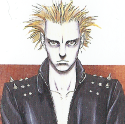

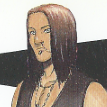
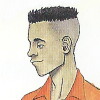


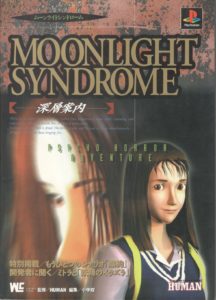
呪力 JURYOKU would have focused on the relationship between certain individuals at Meiryo Private high-school. Toshiki Fuwa, a gang leader, has an intense rivalry with Ryojun Hamura, the leader of the baseball team. However, he secretly longs for his friendship. Ryojun, on the other hand, is involved in his own bizzarre love triangle: he protects a weak boy named Tokio Kusakabe. The boy is helplessly in love with Megumi Sakurai, the manager of Ryojun’s team, whom however has eyes only for Ryojun and resents Tokio for taking up his time. At the same time, Tokio grows resentful of Ryojun, despite him being his protector, for monopolizing the attentions of Megumi.
From his hatred, Hyper Tokio is eventually born: Tokio’s dark side, who torments Megumi in a way similar to how Mithra torments Mika in the game, coming and going between dreams and reality, murdering people with the “Psycho Gun” in his left arm. Megumi, disgusted by the weak Tokio, eventually stabs him.
Toshiki is eventually betrayed by his three underlings (Mitsuru, Nozomu and Satoru) who stab him while he’s distracted. His girlfriend flees the scene without helping him and Toshiki dies dreaming of Ryojun’s friendship.
It is unknown how the two groups would have interacted; the main cast (or at least Yukari) would have gotten involved with the case through Kazuya Kitamura, Yukari’s boyfriend from Twilight Syndrome: after graduating from being a trainee teacher at Hinashiro high-school, he’d begin working at Meiryo Private high-school as a full fledged instructor and he would act as a helpless bystander through the events of the chapter. Suda planned to depict the private lives of Yukari and Kazuya, implying that the two had gotten back together after the events of Twilight, including their sex life. Kazuya was also planned to appear in エピローグ EPILOGUE.
The design of Hyper Tokio would eventually influence that of Tokio Morishima in The Silver Case.
業固 GOKATA (Immutable Karma)



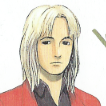



Kanae Saito, a classmate of Mika who usually keeps to herself, is sexually abused by her own father Kyozo, who takes his frustrations out on her. Kyozo is driven insane when he loses his job as a star salary man due to corporate restructuring in the 90s recession. Kanae can’t find any respite in her relationship with Masami Yoshii because he merely sees her as an object for his sexual desires and she has no real friends outside of Rumi, so she eventually takes her own life by slitting her wrists. However, her blood solidifies along with her karma, creating a humanoid monster called the butcher, who kills her father and also three punks (King, Club and Dia) who picked a fight with Kanae and her boyfriend.
Zenko, Arisa Kahara’s brother who dotes on her, is an occult journalist in the same vein as Aramata. He would somehow get involved with the case and watch over Kanae as she vanishes.
Zenko was originally going to be Kazuya’s co-lead in エピローグ EPILOGUE. The design of the punks would eventually inspire the TRUMP crime ring in The Silver Case.
生膿 NAMANO (Festering Life)

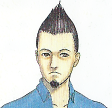



This chapter would have revolved around two twin sisters, Miho and Miwa Misaki, and the secret around their birth. Miho was actually created from a tumor in Miwa’s body, much like Pinoko from Tezuka’s Black Jack. Tatsuya Aihara, a third rate DJ who hangs around at a diner owned by Lost Highway’s bartender and who might be related to Mika’s classmate Kazuki Aihara, is fascinated by the twins and tries to get close to them. However, Shintaro Kazami, their father and a powerful corporatist, hires a hitman to kill him. Tatsuya’s body is taken over by Miho and as he is shot by the hitman, Miwa drags him into the darkness.
陰約 INYAKU (Unseen Appointment)
陰約 INYAKU itself was completely reworked into a short story format; its introduction tells us that, compared to its original publishing in the Playstation Victory Special, some parts were cut and other added. That is to say that this is the “canonical” version of 陰約 INYAKU, or at least the “finalized” one.
It opens on a prologue detailing the role of the god Mithra; he is the god of contract, watching over pacts and covenants with his tens of thousands of eyes. Mithra himself is a contract.
This would have been our first clue to decipher the events of the game; as we already know, Mithra’s “pacts” incite all the major incidents in the game, from Sumio’s pact to separate the Kazan siblings, to Ryo’s pact to save Mika, Riru’s, the headmaster’s and so on.
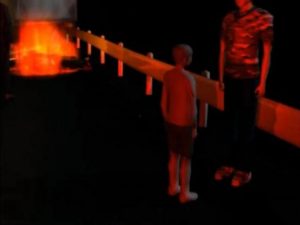
Its first segment would have then showed us the events surrounding Kyoko’s death, which are completely absent from the game itself: Kyoko chose to gave her life up willingly. As she was riding her motorcycle with Sumio she decided to take off her helmet and run into the incoming truck, killing herself to take revenge on her boyfriend’s possessiveness. This is Sumio’s memory: he’s reminiscing about these events as he stands near the flaming truck. Mithra then appears to laugh at him.
This is actually the scene we saw on the news at the end of プロローグ PROLOGUE, where Sumio and Mithra are standing near the wreckage.
Sumio remembers the pact he entered with Mithra (separating the Kazan siblings, which led to Kyoko’s death) whom he understands to be the light of the moon. This is what pays off the foreshadowing present in the game and explains the inciting incident; it also verbalizes the visual motif where Mithra is the “moon” while Yayoi is “the stars” or “space”.
Its second segment is Ryo’s nightmare; after being notified by the police and hearing about the accident on the news, he drives his bike to Reigetsu Pass to identify the body. He blames himself for Kyoko’s death, as he thinks she decided to take her own life because she understood Ryo’s incestuous perversion. (Which is why she has to verbalize the fact that her death was not Ryo’s fault at the edge of the world in エピローグ EPILOGUE.) At the scene of the crime, he is greeted by a policeman who gives him some time to calm down before identifying the body. However Mithra, floating in the night’s sky, starts tormenting him with the image of Kyoko’s charred corpse begging for help. (Again, as a metaphorical “fairy”, Mithra has domain over the realm of dreams.)
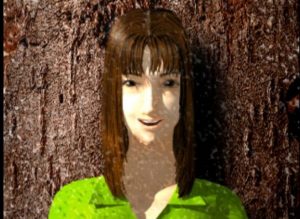
The third segment follows from the previous one, with Ryo being hassled by the journalists at the scene. One of the policemen shows Ryo his sister’s helmet, found undamaged a ways away from the accident, implying that said “accident” was actually a suicide. Telling him not to worry, the policeman tears off the sheet that covered Kyoko’s body, which is when Ryo wakes up screaming and crying.
In order to find solace, he looks at the framed picture next to his bed, which featured him together with his sister, Sumio and Rumi. I am going to assume this is the day they shared together at the peaceful grass field, which later became “the edge of the world” to Ryo and those connected to him. Reassured by his sister’s loving smile, he manages to fall asleep again.
The text describes him as “sleeping like a baby” and this, along with his pathetic cries, is the weak side of Ryo that we are so often told about in the game but is never actually shown. (Again, a lot of the foreshadowing in the game is actually paid off in 陰約 INYAKU.)
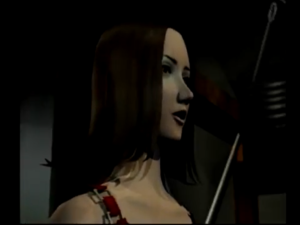
The fourth segment starts with Rumi waking up Ryo again. She tells him that Sumio left, claiming he was going to kill himself, and she blames Ryo for being unable to protect Kyoko, her death having driven Sumio insane. Rumi, who is possessive of her own brother, also resents Ryo for letting Sumio take his beloved sister.
Ryo, despite being angry at Sumio for exiting his life once Kyoko passed away, refuses to let him die and asks Rumi for his whereabouts. She tries to keep Ryo to herself instead, pleading for his help (Rumi wants Ryo to be her caretaker/protector as Sumio’s substitute) but he insists on going to save him. After calming her down he’s told that Sumio headed for Reigetsu Pass, so he jumps on his bike and follows after him despite swearing never go there again.
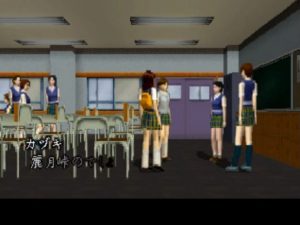
In the fifth segment we see a slightly different version of the events of 予兆 YOCYOU. Instead of being stalked at Lost Highway, Kimika is already friends with Mika and invited her out to drive to Reigetsu Pass after hearing of the accident. Mika is introduced to Mr. Suzuki and as they drive towards Moon Bridge, she remembers the conversation she’s had in プロローグ PROLOGUE about the death of Kyoko, and how she looked exactly like her. Of course in プロローグ PROLOGUE that conversation is immediately followed by comments around Kimika’s death, but I don’t need to remind you that, as Suda has established in the In-depth Guide Q&A, in the reality of Hinashiro as it is twisted by the presence of Mithra the passage of time is warped in the sense that everyone’s perception of the timeline depends entirely on how they felt about the events that have come to pass.

In 陰約 INYAKU, we witness reality as it was before Mithra twisted it: So Mika’s conversation with her classmates would have happened the morning after the accident, rather than several days later. This is similar to how Ryo is depicted here as being fully aware of his sister’s death, while he refuses to accept it even after coming across her severed head in 夢題 MOWDEI.
Regardless of the details, Mika sees Kimika as a reflection of herself: Mika used to exploit other people’s misery as a source of entertainment by dragging her friends into her occult investigations, and she thinks of Kimika’s morbid curiosity over the Reigetsu Pass incident as something similar. In reality, Kimika is just gleeful that Kyoko, whom she saw as a rival for Sumio’s attentions, died horribly. Meanwhile Mika accepts her invitation as a way to assuage her own guilt by witnessing someone else engage in the same behavior she is ashamed of.
Mika, basking in the light of the moon as well as the artificial lights on the bridge, says that she’d be content to die in such a beautiful scenery. Kimika jokes that it might just happen, but there is no laughter in her eyes.
The sixth segment is a short conversation between Yayoi and Sumio; she tries to convince him not to end his life, but Sumio is resolute that there’s no other way out for him. Interestingly, he also tells Yayoi to lower her voice, or “he” might hear them, obviously referring to Mithra. Despite her begging, Sumio eventually drives away to his impending death, asking her to take care of Ryo after he’s gone.
In Sumio’s presence, Yayoi acts like a defenseless, emotional girl, which is where her manipulative tactics come into play. She was trying to build Sumio up into her own protector/caretaker so that he would be the one to take on Mithra and free her: however, as it is revealed here, her efforts are ultimately pointless because Sumio is incapable of feeling any genuine love for her, but only for the deceased Kyoko.
This explains Sumio’s weird comment in 夢題 MOWDEI: When he says that Ryo’s actions have “hurt” Yayoi, is because in his mind she exists as a frail girl who has fallen pray to Sumio’s needs of finding a substitute for Kyoko, which wouldn’t have happened if Ryo’s weakness hadn’t interfered with their relationship.
In the seventh segment, the Alfa Romeo driven by Suzuki which housed Mika and Kimika has a near collision with Sumio’s motorbike: the two girls instantly recognize Sumio as he almost hits the car and presumably falls down the valley. (The narrative is unclear on this; it seems that Sumio’s bike just disappears.)
Realizing they haven’t been hit, Mika and Kimika leap out of the car; however, upon realizing that Sumio has just killed himself in front of her, Kimika is driven insane by being denied the opportunity to kill him and begins dragging Mika away, who finally realizes she is in danger.
The eight segment has Yayoi step in front of Ryo’s bike to stop him as he’s looking for Sumio on the pass. Ryo can sense the animosity permeating from her body. As she introduces herself to Ryo, she hints at the fact that Sumio has told her about his incestuous tendencies. Frustrated, Ryo tries to pry Sumio’s location from her, but she responds that as a friend he should let him die in peace.
Her façade of innocence from her previous appearance is completely gone; having ascertained that Sumio is no longer useful for her, she is ready to throw him away.
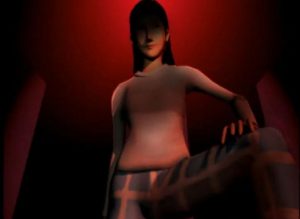
Yayoi steps in closer, taunting Ryo with her voluptuous body. She calls Ryo a siscon, and while claiming that it must be painful to have no outlet for such feelings, she proposes herself as Kyoko’s substitute, to be Ryo’s sexual partner.
Ryo sees through her façade and rejects her, to which she responds that he is more rational than she expected in a line reminiscent of their introduction in 夢題 MOWDEI. She then tells him that his sister did reciprocate his feelings, before stepping away and spitting on the ground calling him a pervert.
She follows this up by saying that his perversion is the reason why Kyoko chose to be with Sumio instead, playing on his insecurities. Ryo, resettling his bike, tells her that people don’t like to hear certain things. As he drives away, Yayoi pities his ill-fated destiny and bids him farewell.
In the ninth and final segment, Ryo realizes that Yayoi was just trying to waste his time in order to lead Sumio to his death. He speeds up, but he has trouble overtaking the car in front of him, which happens to be Suzuki’s Alfa Romeo. Kimika, completely mad, somehow managed to steal Suzuki’s car and knock Mika out. As she is slumped on the backseat, Kimika speaks to her as if Sumio were still alive and she was gonna share him with Mika after she regained control of him.
Ryo, keeping pace with the car, notices Mika lying unconscious and mistakes her for Kyoko. He also notices that Kimika has gone completely crazy and shouts at her to stop the car.
Kimika ignores him, so he tries to wake Mika up, telling her to take control of the car. However, that is also unsuccessful. As Ryo hears Mithra’s laughter in the air, the two vehicles collide.
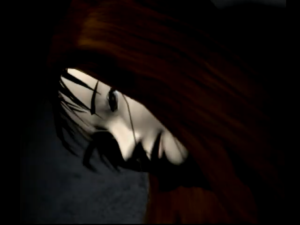
As his bike is drifting on the asphalt, Ryo sees the car smoking next to a dented guard rail. He lets go of the bike and rushes to the Alfa Romeo, wanting to save “Kyoko” (Mika). He notices Kimika’s arms and legs sticking out of the front of the car, but ignores them. Looking for Mika in the backseat, he is relieved to see her sporting a peaceful expression. Still convinced that she is Kyoko he tries to pull her away from the wreckage: However, her upper body actually falls from his arms and onto the asphalt.
This is why, when passing out in front of the nurse in 電破 DENPOW, Mika mysteriously hears the sounds of a car crash: This is where she originally died, what was “meant” to happen to her without Ryo’s interference.
It’s also possible that the image of Mika’s dead body we see after Ryo slays Mithra in エピローグ EPILOGUE was going to be a callback to this very same scene. Mithra’s cryptic comment, “This is the answer”, then becomes more clear: Mika had always been dead, that was her fate since the beginning. Having her live a few more months was just part of Mithra’s game.
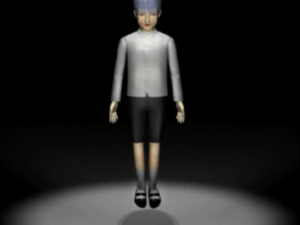
Ryo cries out, having just relived the trauma of his sister’s death, and almost as if hearing his cries, Mithra appears from thin air in the form of the white haired boy. He reassures Ryo that the girl in front of him is not Kyoko; however, the two are one and the same. (Mika, by fulfilling Kyoko’s role, becomes her substitute.)
He then claims responsibility for her death, presumably because he’s the one who distracted Ryo by whispering in his ear as he was driving.
From this point onwards, these are the same events that were covered in 輪廻 RINNE, though the wording is slightly different:
Ryo recognizes the boy from the scene of the accident (it’s mentioned earlier in this chapter that he has seen the news report we as players were shown in プロローグ PROLOGUE). Mithra ignores him, telling Ryo that he knows all about the love quadrangle involving the Kazan and Tohba siblings. When asked about his intentions, Mithra simply responds that he wants to be their playmate. He also reveals to Ryo that Kyoko rejected his help, implying that, at some point, he also offered her a contract. What we’re getting at here is that Kyoko probably chose death over Mithra’s contract as a means to protect Ryo, which is likely what Sumio’s comment in エピローグ EPILOGUE about needing true love to die for another’s sake was referring to.
Mithra becomes annoyed with Ryo’s cries and paralyzes him with a flash of light, similarly to how he would do to Yukari in エピローグ EPILOGUE, then continues speaking. Since Kyoko is not there anymore, he’ll have to “use” Mika (in order to stage his tragedy), but as she is dead, they’re gonna have to help her first. However, in order to help Mika, Ryo has to ask him. As was established in 陰約 INYAKU’s prologue, Mithra’s role is simply to watch over contracts and covenants, or in other words, he himself is a contract. Mika’s pathetic voice starts tormenting Ryo, and Mithra leans in towards him, putting his hand near his head in a childish mimicry of straining his ear.
Ryo, frozen, does not respond, but Mithra takes in his silent wish regardless: Mika will be restored to life, but in exchange, Mithra will take the first living person that Ryo will embrace, or hold in his arms. That is to say that, in exchange for Mika’s life, Ryo must offer up the woman he loves, and so, from this point onwards, he’ll do everything in his power to make sure that Ryo falls for Mika in order for his tragedy to play out.
As his movement is restored, Ryo loses all conscious memory of this transaction. There is a point brought up in the Q&A which I find quite confusing, but apparently it’s implied that in order to ascertain Ryo’s wishes in this scene, Mithra actually manifested to him as Sumio, while the omniscient narration describes him as being paralyzed:
You could say that Sumio’s contract was the beginning of everything that happens in the story. So, what was it that he wanted? It was the eternal separation of Kyoko and Ryo. He apparently offered up his own death and soul to Mithra for this. Does this mean that Ryo formed a contract with Mithra about Mika? This is not the case. It seems as though Ryo thought Mithra to be Sumio when he made contact with him. Sumio must have been quite important to him. When executing Sumio’s contract, pointing out the existence of Mika to Ryo and making him choose of his own volition whether or not to protect her, you might say that Mithra was displaying the majesty of a god of justice…?
Source.
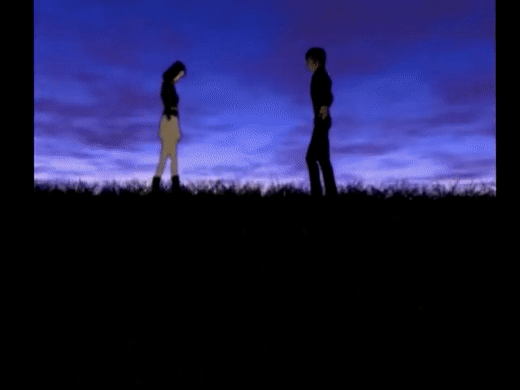
In the epilogue, Ryo is riding his bike through Reigetsu Pass as the sun begins to lighten the night sky. The narrative comments on how Sumio had “died without telling him anything”, which I suppose is our hint towards the fact that he remembers his interaction with Mithra as if he had actually met with Sumio, who instead vanished in front of the Alfa Romeo.
However, Mithra’s voice taunts him once more, saying that he won’t let the story end yet. As he drives he spots a figure of a woman and stops his bike. That woman was Mika: exhausted, as she sees Ryo, she falls into his arms, and he embraces her tightly with all of his affection. A childish laugh reverberates through the wind.
Had 陰約 INYAKU been included, the final embrace that Mika and Ryo share at the end of エピローグ EPILOGUE would have brought the story to a full circle: the nightmare caused by Mithra is over and they can finally embrace one another without endangering each other’s lives; however, this can only happen at the edge of the world, a place of feeling and memory, where their worldly lives have been left behind.
As this story draws to a close, most of the game’s mysteries are now clarified, or we have at least been given a key through which to decipher them: Through his acquaintance with Yayoi, Sumio reaches out to Mithra, the god of contract, in order to enter a pact: to separate the Kazan siblings once and for all and have Kyoko to himself. At the same time, Yayoi has been trying to groom Sumio into her protector, so that he would stand up to Mithra for her sake and strike him down, freeing her. However, the result of Sumio’s contract is that Kyoko is killed, and he ends up receiving her severed head instead. Mithra does try to lure Kyoko into a contract as well, but she refuses, choosing death instead. Sumio, driven mad by loss, kills himself, and Yayoi’s attempts to replace him with Ryo. Ryo, however, does not fall for her sexual advances and pursues Sumio. At the same time, seeing Sumio die before she could enact her revenge on him drives Kimika insane, and she kidnaps Mika, who is the spitting image of Kyoko. Ryo gets into a gruesome accident with the two of them and, in order to save Mika, who reminds him of his sister, subconsciously enters an agreement with Mithra for her life.
This is the second contract that happens chronologically through the story; through the course of the game Mithra, whose only objective is to delight himself with a show of humans destroying each other by making their wishes come true, accumulates more and more power over the town of Hinashiro as he takes on more contracts with several other individuals, which is why the timeline and reality of Hinashiro start breaking down entirely through the course of the game. Everyone’s conflicting wishes are informing reality, but as each person in the newly-urbanized Hinashiro is atomized and thinks only of their own gain, said wishes are conflicting, making its “reality” nonsensical.
The timeline is rewritten so that the accident did not happen; that means that Sumio never died in front of Kimika’s car, driving her to kidnap Mika. The events instead proceed as they did in 予兆 YOCYOU, with Kimika taking Mika for a drive but deciding to take her and Sumio’s life instead. Mika safely gets home, and the events of 夢題 MOWDEI take place.
While 陰約 INYAKU is described as an “alternate version” of 夢題 MOWDEI, I very much doubt that it would have played out in its stead, as it spoils all of the game’s major twists. It was much more likely going to play out near the end of the game. This is what Suda is getting at when he describes the whole of Hinashiro going through the same mental revolution as Ryo himself in the In-depth Guide Q&A: the town we see is quite literally being shaped by their desires being made true.
Could the story of Moonlight Syndrome be considered to have taken place within Ryo’s inner universe? Or do the inexplicable events that occur during the story actually occur in the real world?
What would happen if the phenomenon of mental revolution that Ryo undergoes, triggered by the death of Kyoko, happened not just to him but to the whole of Hinashiro? The headmaster, Kimika Takahashi, the people at the club… If all of the people scattered across town, too many to depict, were to simultaneously undergo this internal revolution…
I think of it as a realistic story with this exaggerated to an extreme.
Ryo definitely does exist within Hinashiro, and he experiences a realistic story up until Dowaku. There is no definite explanation for the epilogue. You could say that all of the characters in the story are walking along by themselves, and so at one point I had to rewrite the epilogue due to the circumstances of their journeys. The events are completely different.
Source
Sumio and Kimika, the victims of 陰約 INYAKU, being left without a protector (i.e. one that would enter a contract for their sake in order to preserve their life) die once again, as Sumio’s life was already offered as compensation for the separation of the Kazan siblings, but without involving Mika. At the same time, Yayoi is also reintroduced to Ryo, but instead of just trying to use her sexual charms and her façade of innocence in order to forge him into a protector who will kill Mithra, she instead decides to use Kyoko’s memory, as she has learned from experience that neither man would ever love her more than they did Kyoko.
Mithra, in order to stage a tragedy, and Yayoi, in order to forge Ryo’s “inner weapon”, both begin tormenting Mika (Kyoko’s substitute) and luring her into traps and danger so that Ryo will have no choice but to fall in love with her and take charge as a man, which of course he eventually does. This leads to the events of エピローグ EPILOGUE, in which Ryo finally musters the strength to end the god of contract once and for all. However, this comes at the cost of Mika’s life, as Mithra himself was the one keeping her alive in accordance to his covenant with Ryo. There was never any hope for her: rejecting the contract would have meant her death in the car accident, protecting her from Mithra would have meant she’d be taken by him as payment, and killing him meant her death.
This closes the curtain on the story of Moonlight Syndrome: in this incredibly nihilistic tale, humans did nothing but destroy one another, and even gods fell victims to their own desires; Mithra’s passion for tragedy is what ultimately leads him to his death, while Yayoi’s manipulations twist her into an unlovable, unloving person who ends her role with regret.
Most of the characters we’ve come to know have died except for Rumi and Ryo, with Ryo’s fate being left ambiguous as he comatosely looks at Mika’s spirit into his television screen. However, a glimmer of hope exists at the edge of the world, where having left their worldly lives behind, two imperfect lovers can finally embrace each other.

